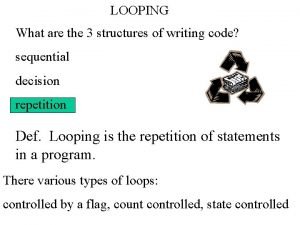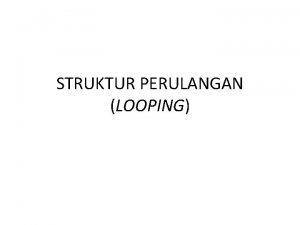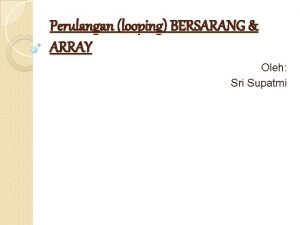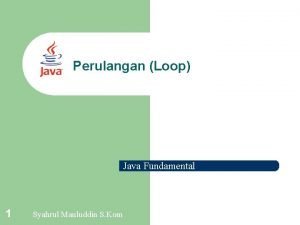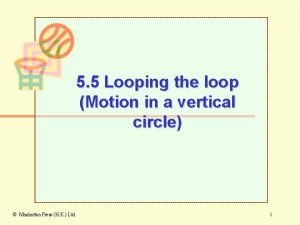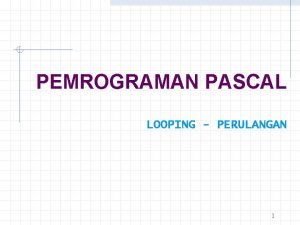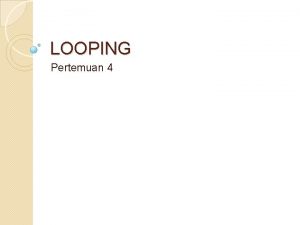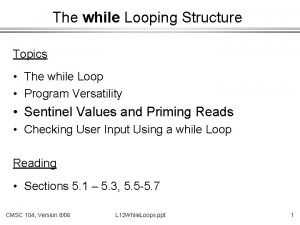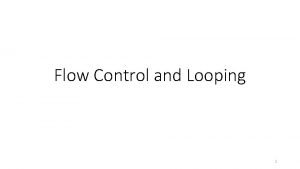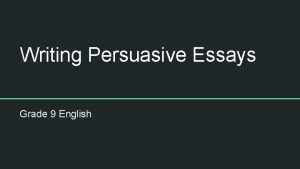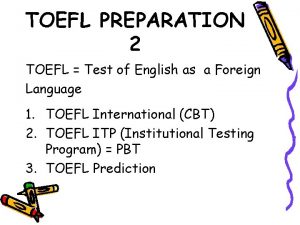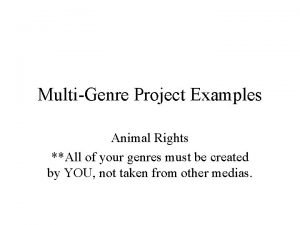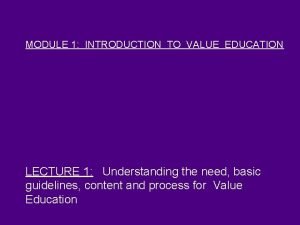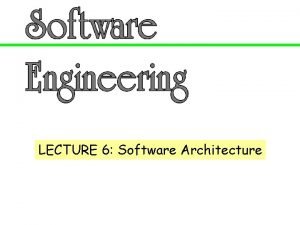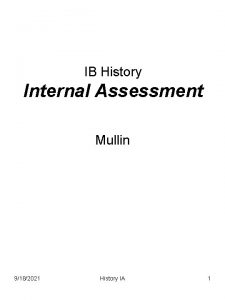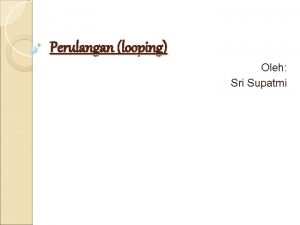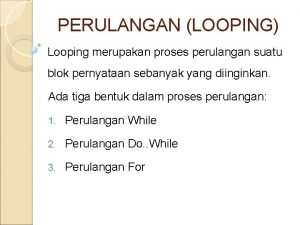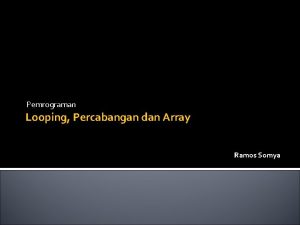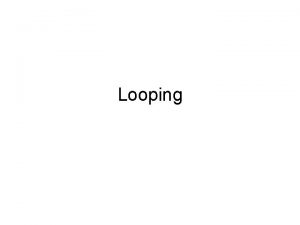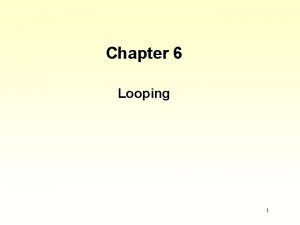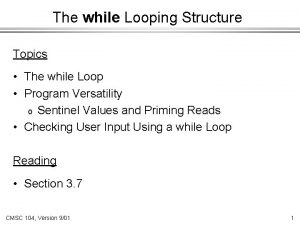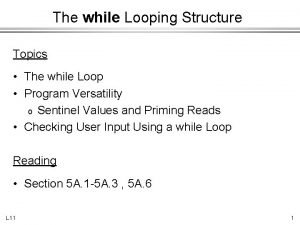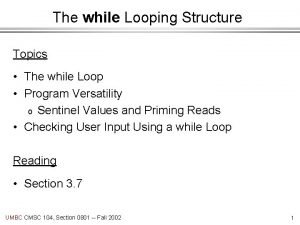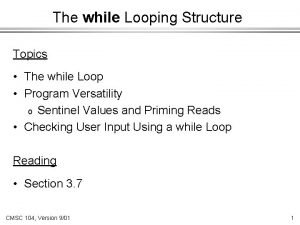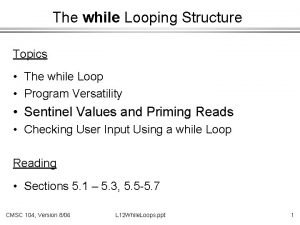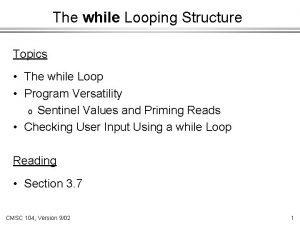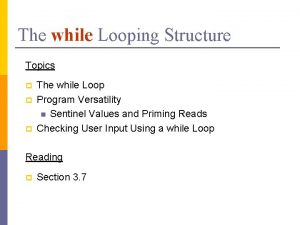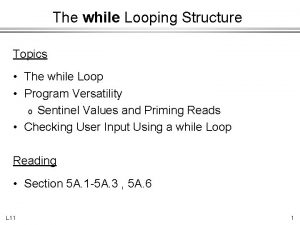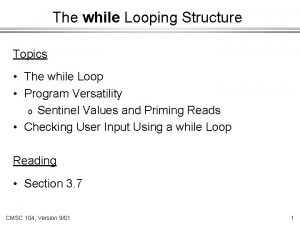Chapter 6 Looping Chapter 6 Topics l l

































































- Slides: 65

Chapter 6 Looping

Chapter 6 Topics l l While Statement Syntax Count-Controlled Loops Event-Controlled Loops Using the End-of-File Condition to Control Input Data

Chapter 6 Topics l l l Using a While Statement for Summing and Counting Nested While Loops Loop Testing and Debugging

Loops What is a loop? A loop is a repetition control structure that causes a single statement or block to be executed repeatedly

Two Types of Loops Count controlled loops Repeat a statement or block a specified number of times Event-controlled loops Repeat a statement or block until a condition within the loop body changes that causes the repetition to stop

While Statement SYNTAX while (Expression) {. . . } // loop body Loop body can be a single statement, a null statement, or a block

• When the expression is tested and found to be false, the loop is exited and control passes to the statement that follows the loop body WHILE LOOP FALSE Expression TRUE body statement

Count-Controlled Loops Count-controlled loops contain: n An initialization of the loop control variable n An expression to test if the proper number of repetitions has been completed n An update of the loop control variable to be executed with each iteration of the body

Count-Controlled Loop Example int count; count = 4; // Loop-control variable // Initialize loop variable while(count > 0) // Test expression { cout << count << endl; // Repeated action count --; } cout // Update loop variable << “Done” << endl;

Count-controlled Loop int count; count = 4; while(count > 0) { cout << count << endl; count --; } cout << “Done” << endl; OUTPUT

Count-controlled Loop int count; count = 4; while(count > 0) { cout << count 4 OUTPUT << endl; count --; } cout << “Done” << endl;

Count-controlled Loop int count; count = count 4; 4 while(count > 0) TRUE { cout << count << endl; count --; } cout << “Done” << endl; OUTPUT

Count-controlled Loop int count; count = count 4; while(count > 0) { cout << count 4 << endl; count --; } cout << “Done” << endl; OUTPUT 4

Count-controlled Loop int count; count = count 4; while(count > 0) { cout << count 3 << endl; count --; } cout << “Done” << endl; OUTPUT 4

Count-controlled Loop int count; count = 4; while(count > 0) TRUE { cout << count << endl; count --; } cout << “Done” << endl; count 3 OUTPUT 4

Count-controlled Loop int count; count = count 4; 3 while(count > 0) { cout << count << endl; count --; } cout << “Done” << endl; OUTPUT 4 3

Count-controlled Loop int count; count = 2 4; while(count > 0) { cout << count << endl; count --; } cout << “Done” << endl; OUTPUT 4 3

Count-controlled Loop int count; count = 4; while(count > 0) TRUE { cout << count << endl; count --; } cout << “Done” << endl; count 2 OUTPUT 4 3

Count-controlled Loop int count; count = 2 4; while(count > 0) { cout << count << endl; count --; } cout << “Done” << endl; OUTPUT 4 3 2

Count-controlled Loop int count; count = count 4; while(count > 0) { cout << count 1 << endl; count --; } cout << “Done” << endl; OUTPUT 4 3 2

Count-controlled Loop int count; count = 1 4; while(count > 0) { cout << count TRUE << endl; count --; } cout << “Done” << endl; OUTPUT 4 3 2

Count-controlled Loop int count; count = 1 4; while(count > 0) { cout << count << endl; count --; } cout << “Done” << endl; OUTPUT 4 3 2 1

Count-controlled Loop int count; count = 0 4; while(count > 0) { cout << count << endl; count --; } cout << “Done” << endl; OUTPUT 4 3 2 1

Count-controlled Loop int count; count = 4; while(count > 0) FALSE { cout << count << endl; count --; } cout << “Done” << endl; count 0 OUTPUT 4 3 2 1

Count-controlled Loop int count; count = 0 4; while(count > 0) { cout << count << endl; count --; } cout << “Done” << endl; OUTPUT 4 3 2 1 Done

Example my. Infile contains 100 blood pressures Use a while loop to read the 100 blood pressures and find their total

ifstream int int my. Infile; this. BP; total; count; count = 0; // Initialize while (count < 100) { my. Infile >> this. BP; total = total + this. BP; count++; } // Test expression cout total << “The total = “ << // Update << endl;

Types of Event-Controlled Loops l Sentinel controlled Keep processing data until a special value that is not a possible data value is entered to indicate that processing should stop l End-of-file controlled Keep processing data as long as there is more data in the file l Flag controlled Keep processing data until the value of a flag changes in the loop body

Examples of Kinds of Loops Count controlled loop Read exactly 100 blood pressures from a file End-of-file controlled loop Read all the blood pressures from a file no matter how many are there

Examples of Kinds of Loops Sentinel controlled loop Read blood pressures until a special value selected by you(like -1) is read Flag controlled loop Read blood pressures until a dangerously high BP(200 or more) is read

A Sentinel-controlled Loop l Requires a “priming read” l A priming read is the reading of one set of data before the loop to initialize the variables in the expression

// Sentinel controlled loop total = 0; cout << “Enter a blood pressure(-1 to stop) ”; cin >> this. BP;

// Sentinel controlled loop, cont. . . while(this. BP != -1) // While not sentinel { total = total + this. BP; cout << “Enter a blood pressure(-1 to stop)”; cin >> this. BP; } cout << total;

End-of-File Controlled Loop l Uses the fact that a file goes into the fail state when you try to read a data value beyond the end of the file to control the loop

// End-of-file controlled loop total = 0; my. Infile >> this. BP; // Priming read

// End-of-file controlled loop, cont. . . while(cin) // While last read successful { total = total + this. BP; cout << “Enter blood pressure”; cin >> this. BP; // Read another } cout << total;

// End-of-file at keyboard total = 0; cout cin << “Enter blood pressure “ << “(Ctrl-Z to stop)”; >> this. BP; // Priming read

// End-of-file at keyboard, cont. . . while(cin) // While last read successful { total = total + this. BP; cout << “Enter blood pressure”; cin >> this. BP; // Read another } cout << total;

Flag-controlled Loops Initialize a flag (to true or false) l Use meaningful name for the flag l A condition in the loop body changes the value of the flag l Test for the flag in the loop test expression l

Example of Flag-controlled Loop count. Good. Readings = 0; is. Safe = true; // Initialize Boolean flag while(is. Safe) { cin >> this. BP; if (this. BP >= 200) is. Safe = false; // Change flag value

Example, continued else count. Good. Readings++; } cout << count. Good. Readings << endl;

Common Loop Uses l Count all data values l Count special data values l Sum data values l Keep track of current and previous values

Current and Previous Values l Write a program that counts the number of != operators in a program file l Read one character in the file at a time l Keep track of current and previous characters

Keeping Track of Values previous current count (x != 3) { cout << endl; } ( x 0 x ‘‘ 0 ‘‘ ! 0 FILE CONTENTS ! = 1 = ‘‘ 1 ‘‘ 3 1 3 ) 1

Loop Program Keeping Track of Current and Previous Values int char count; previous; current; count = 0; in. File. get(previous); in. File. get(current); // Priming reads

Keeping Track of Current and Previous Values , continued while(in. File) { if((current == ‘=‘) && (previous == ‘!’)) count++; previous = current; // Update in. File. get(current); // Read another }

Nested Loops initialize outer loop while (outer loop condition) {. . . initialize inner loop while(inner loop condition) { inner loop processing and update }. . . }

Patient Data A file contains blood pressure data for different people. Each line has a patient ID, the number of readings for that patient, followed by the actual readings. ID 4567 2318 5232 how. Many Readings 5 2 3 180 140 150 170 120 170 210 151 151

Read the data and display a chart Patient ID BP Average 4567 152 2318 190 5232 151. . . There were 432 patients in file.

Algorithm § Initialize patient. Count to 0 § Read first ID and how. Many from file

Algorithim, cont. . . § While not end-of-file § Increment patient. Count § Display ID § Read and sum this patient’s BP’s § Calculate and display average for patient § Read next ID and how. Many from file § Display patient. Count

Designing Nested Loops l Begin with outer loop l When you get to where the inner loop appears, make it a separate module and come back to its design later

Designed Nested Loop Example #include <iostream> #include <fstream> using namespace std;

Designed Nested Loop Example int { main() int int int patient. Count; // Declarations this. ID; how. Many; this. BP; total. For. Patient; count; float average; ifstream my. Infile;

Designed Nested Loop Example, cont. . my. Infile. open(“BP. dat”); if (!my. Infile) // Opening failed { cout << “File opening error. Program terminated. ”; return 1; } cout << “ID Number Average BP” << endl; patient. Count = 0; my. Infile >> this. ID >> how. Many; // Priming read

Designed Nested Loop Example, cont. . while(my. Infile) // Last read successful { patient. Count++; cout << this. ID; total. For. Patient = 0; // Initialize inner loop count = 0; while(count < how. Many) { my. Infile >> this. BP; count ++; total. For. Patient = total. For. Patient + this. BP; }

Designed Nested Loop Example, cont. . average = total. For. Patient / float(how. Many); cout << int(average +. 5) << endl; // Another read my. Infile >> this. ID >> how. Many; } cout << << “There were “ << patient. Count “patients on file. ” << endl; cout << return 0; } “Program terminated. ” << endl;

Information About 20 Books in Diskfile “my. In. dat” Price of book Hardback or Paperback? 3. 98 P <eoln> 7. 41 H <eoln> 8. 79 P <eoln>. . . Write a program to find total value of all books

C++ Program #include <iostream> #include <fstream> // Access cout // Access file I/O using namespace std; int { main(void) float char ifstream float int price; kind; my. Infile; total = 0. 0; count = 1; // Declarations

C++ Program, cont. . . my. Infile. open(“my. In. dat”); // count-controlled processing loop while( count <= 20) { my. Infile >> price >> kind; total = total + price; count ++; } cout << “Total is: “ << total << endl; my. Infile. close(); return 0; }

Trace of Program Variables count 1 2 3 4 20 21 price 3. 98 7. 41 8. 79 etc. kind ‘P’ ‘H’ ‘P’ so loop terminates total 0. 0 3. 98 11. 39 20. 18

Complexity l Complexity is a measure of the amount of work involved in executing an algorithm relative to the size of the problem

Polynomial Times N N 0 N 1 N 2 N 3 constant linear quadratic cubic 1 1 10 100 1, 000 1 100 10, 000 1, 000 1 1, 000, 000 10, 000 100, 000 1, 000, 000

Loop Testing and Debugging l Test data should test all sections of program l Beware of infinite loops -- program doesn’t stop l Check loop termination condition, and watch for “off-by-1” bugs(OBOBs) l Use get function for loops controlled by detection of ‘n’ character

Loop Testing and Debugging l Use algorithm walk-through to verify preand post conditions l Trace execution of loop by hand with code walk-through l Use a debugger to run program in “slow motion” or use debug output statements
 Contoh flowchart perulangan for
Contoh flowchart perulangan for Program pascal perulangan
Program pascal perulangan What is looping in writing
What is looping in writing Bentuk umum dari pernyataan perulangan for adalah...
Bentuk umum dari pernyataan perulangan for adalah... Qbasic loops
Qbasic loops Nested array
Nested array Perulangan bersarang java
Perulangan bersarang java Disadvantages of looping in education
Disadvantages of looping in education Decision making and looping in c
Decision making and looping in c Dangling error in network
Dangling error in network Counter loop example
Counter loop example Loop aircraft motion
Loop aircraft motion Contoh struktur dasar algoritma
Contoh struktur dasar algoritma Looping pemrograman
Looping pemrograman For to do pascal
For to do pascal For loop small basic
For loop small basic Loop logic programming
Loop logic programming Flowchart alih kontrol
Flowchart alih kontrol Looping
Looping Ironetican
Ironetican While loop forever
While loop forever What is a workaround
What is a workaround Perulangan looping
Perulangan looping Nested loops python
Nested loops python Perulangan looping
Perulangan looping Chapter 9 topics in analytic geometry
Chapter 9 topics in analytic geometry How to write school magazine
How to write school magazine Persuasive writing example year 9
Persuasive writing example year 9 Analytical essay intro example
Analytical essay intro example Behavioural training topics
Behavioural training topics Skill 27 listen for answers in order
Skill 27 listen for answers in order Purpose of interview
Purpose of interview Informative and surprising essay topics
Informative and surprising essay topics Theme in the great gatsby
Theme in the great gatsby What is a thematic topic
What is a thematic topic Easy table topics
Easy table topics Subjective topics examples
Subjective topics examples Solo talk examples
Solo talk examples Software project management topics
Software project management topics Sociolinguistics topics
Sociolinguistics topics Smaw topics
Smaw topics Pertanyaan untuk pemateri seminar
Pertanyaan untuk pemateri seminar Youth gathering theme
Youth gathering theme P6 science syllabus
P6 science syllabus Customer service topics for discussion
Customer service topics for discussion Statement of the problem about overpopulation
Statement of the problem about overpopulation Philosophical chairs topics
Philosophical chairs topics Problem solution persuasive speech
Problem solution persuasive speech Peran pemimpin dalam keperawatan
Peran pemimpin dalam keperawatan Leaflet sentence starters
Leaflet sentence starters In an outline the relationship of topics
In an outline the relationship of topics Osslt essay topics 2021
Osslt essay topics 2021 Features of a newspaper
Features of a newspaper Tv poster
Tv poster What are the basic guidelines of value education?
What are the basic guidelines of value education? Management information system topics
Management information system topics Vts-0fxyt-e -site:youtube.com
Vts-0fxyt-e -site:youtube.com Safety topics for february
Safety topics for february Scope of operation research
Scope of operation research Kubernetes topics
Kubernetes topics Texas hosa competitive events
Texas hosa competitive events Original oratory topics
Original oratory topics Reflection on lac session
Reflection on lac session Section c history ia
Section c history ia English b topics
English b topics Topics in sports nutrition
Topics in sports nutrition


